Why La Scala really is opera's highest temple.
All this drama made me remember heearing, in Milan, that there is a secret passageway between La Scala and the Duomo. Word is, Toscanini used it as a quick getaway from divas' jealous husbands!
Radio host shares thoughts on all sorts of stuff, which might even be related to her work on occasion.
All this drama made me remember heearing, in Milan, that there is a secret passageway between La Scala and the Duomo. Word is, Toscanini used it as a quick getaway from divas' jealous husbands!
Posted by
Gillian Coldsnow
at
5:59 PM
1 comments
![]()
Roberto Alagna's wife, the Romanian soprano Angela Gheorghiu, is also known for her diva displays. The New York Times writes:
"Mr. Alagna’s wife, Angela Gheorghiu, has just withdrawn from a Royal Opera production of “Don Carlo” in London next season. A company spokesman said she was “uncomfortable” with the role.
"The couple have had their problems in the past. Ms. Gheorghiu refused to wear a blond wig during a Metropolitan Opera tour of “Carmen” in Japan and was replaced by her understudy for a performance. The Met also withdrew a contract for the couple for “La Traviata,” apparently over a dispute about the set design. They have since been invited back."
I've read Roberto and Angela are called ``the Bonnie and Clyde'' of opera, and Gheorghiu has been called 'Draculette.'
But unlike Alagna, Ms. Gheorghiu is a darling of La Scala. So when her husband threatened that the both of them would withdraw from performances there, she can't have been too happy.
Wouldn't you love to be fly on their wall? Impromptu opera!
Posted by
Gillian Coldsnow
at
5:48 PM
0
comments
![]()
The end of the now-infamous Aida performance brought a 9-minute ovation, much of it for the man who took Roberto Alagna's place after the insulted tenor stormed off stage.
Antonello Palombi went on stage still dressed in jeans and a long black shirt. Why wouldn't an understudy have been fully prepped to step into the role at a moment's notice? Curious, don't you think?
Get this: apparently, Palombi was the third understudy in line! Was he just a lot quicker on the draw than the first understudy, was in full costume? Was #1 snoozing, and therefore losing this grand opportunity? All that press!
Three understudies - that we know of. Just how deep of a bench do they have at La Scala, anyway? And remember: the Italian government pays for 90 percent of La Scala's costs! Tickets account for only ten percent of its operating budget. No fundraising. This public radio employee is beyond green with envy!
Here's Corriere della Sera's report, in English, on the December 9th drama.
Gillian Coldsnow
Posted by
Gillian Coldsnow
at
8:05 AM
0
comments
![]()
No tempest in a teacup, this. Tenor Roberto Alagna, singing Radames on Sunday night (December 9) just couldn't stomach the boos coming from the tough loggionisti (balcony spectators) at La Scala and stomped off the stage, leaving his leading lady to struggle through the duet by herself.
Everyone's talking about it. Even people who don't care for opera have heard about it. It seems that the diva tantrums of yore really don't happen very much these days (oh, wait, of course, there WAS Kathleen Battle) - so that this big tenor hissy fit made news all over the world.
I found a blog of an opera lover in Milan who gives all the dirt, and then some (!) on this incident and its continuing fallout. Read Opera Chic for some good old-fashioned opera-drama-behind-the-scenes!
I really love what one opera critic said on the BBC. When asked why Alagna would jeopardize his career by stomping of the stage of THE temple of opera, the critic said, "well, tenors are notoriously fragile creatures."
Gillian Coldsnow
Posted by
Gillian Coldsnow
at
1:22 PM
0
comments
![]()
Labels: aida, alagna, la scala, opening night, opera, scandal, understudy
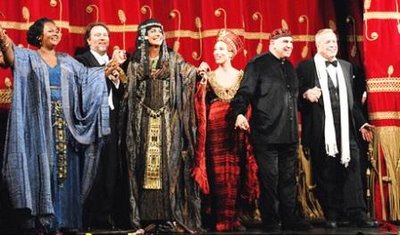
The La Scala season always begins on December 7th, because it's the feast day of Milan's patron saint, Ambrose.
Don't even think about trying to score tickets for the star-studded affair, which rivals any Hollywood red carpet affair.
The opening show? Possibly Italy's most beloved opera, Verdi's Aida. Director Franco Zeffirelli says it's the best production of Aida La Scala has ever seen.
THE STANDING OVATION LASTED 15 MINUTES.
Was it, as Playbill writes, "the Aida of Aidas?"
Since I couldn't be there (boo!! hisss!!!) I'm sending you to the Beeb for pictures.
Posted by
Gillian Coldsnow
at
8:40 AM
0
comments
![]()
Labels: aida, gold, la scala, opening night, verdi, zeffirelli

Above: What is distracting Sandi and Ljiljana? It was early and there were few other people in the square at that hour.
Our first full day in Italy took us to Milan's Piazza del Duomo. (Aaaaaargh!! Get those bloody pigeons off me!!) Between the ornate cathedral and the statue of Italy's king Vittorio Emmanuele, our guide for the day, Marica, gave us a primer on the city's complicated list of rulers. She pulled people from the crowd to stand in for Milanese dukes, Austrian princesses, French kings and the like, as she narrated. She had to use almost every person in the large group to get through the presentation!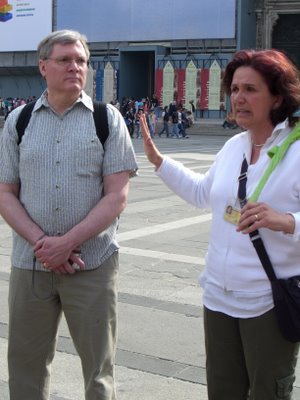
Above: Marica picks Blaine to represent the first Duke of Milan.
Prada purse slung over her shoulder, Marica told us (in a wonderful Cockney accent with German and Italian inflections!) Milan was first ruled by lords from the house of Della Torre, then the lords of the house of Visconti.
To the best of my memory, the tenth Visconti ruler gave himself the ducal title, making him to Duke of Milan #1.
The son who became Duke #2 continued a legacy of cruelty, for which he was assassinated.
His brother became Duke #3. This guy had no sons, so hired a mercernary for battlefield duty. He was happy to have a good warrior on staff, and to make sure this soldier didn't freelance with other states, #3 offered his six-year old daughter in marriage. Never mind that this soldier, Francesco, was 24 years older than the child. Never mind that Francesco was already married.
To cut a long story short: #3 dies, last of his line. Buh-bye, Viscontis. Francesco marries the child, becomes Duke #4 and establishes his own dynasty. Hello, Sforzas. Your name will always be associated with Milan, and the castle Francesco builds, bearing your name, will be one of the city's best-known landmarks, the Castello Sforzesco.
And thus begins the Ambrosian Republic (named for the city's patron saint.)
Francesco's son in Duke #5. We think he poisoned his mother, a pretty tough chick who kept her finger in Milanese politics. He's nasty. He's assassinated.
The title goes to his 7-year old brother. Duke #6 obviously isn't ready for ducal duty, so his uncle does the job. #6 mysteriously dies from poisoning (oh, the rumor mill had quite a workout that year!)....
And Uncle Lodovico becomes Duke #7. He loses Milan to the French!! Then the Swiss get involved, Milan goes back to #7 - briefly. Then it goes back to the French. Then it goes to Lodovico's son....
Maximilian Sforza is Duke #8.
Thereafter, it was French rule, Spanish rule, Austrian rule, rule by the Holy Roman Empire - not necessarily in that order.
The only reason I remember as much of the history lesson as I do, was because of Marica's very lively and informed presentation - in three languages. Since our group was combined with two other groups for the morning, there were Spanish, German and English speakers, and Marica repeated each chapter effortlessly in each of those languages.
Coming from Milan with its rich multi-cultural heritage, it's no wonder its citizens, such as Marica are such accomplished multi-linguists! Arianna, also a Milanesa, speaks English, French, Spanish and Swedish, and the Milanese dialect.
Milan's colorful political history stablized (at least temporarily) under the reign of King Vittorio Emanuel II, who united Italy.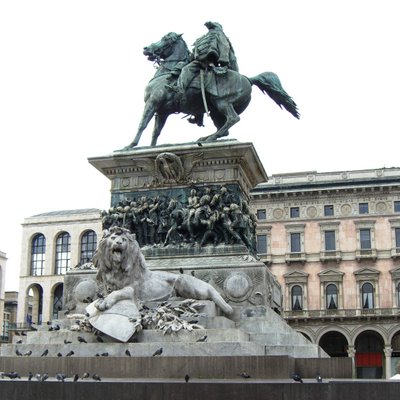
This statue of Vittorio Emanuele (Aaaaaargh!! Get those bloody pigeons off me!!) is one of the main features of the Piazza del Duomo, and the incredible Galleria that links the Duomo and La Scala piazze is also named for him.
Here are links to my earlier Milan posts:
The Duomo and Galleria
Saturday afternoon in the Piazza del Duomo
On the roof of the Duomo
Gillian Coldsnow
Posted by
Gillian Coldsnow
at
8:09 AM
0
comments
![]()
Labels: duke, duomo, francesco sforza, lodovico, milan history, piazza
If you've been following this blog since the beginning, you know that chief among the things that move me are opera, Puccini, food and the Italian notion of bella figura.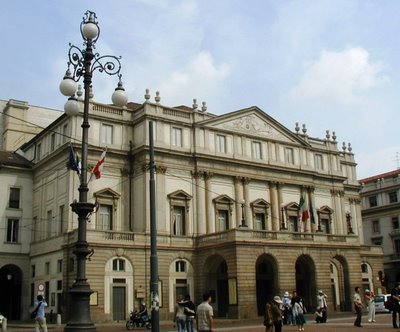
I found them all in my day at La Scala, followed by the performance of Massenet's Manon we attended that evening.
Here's how the whole evening played out.
We rode the subway for three short stops to the Piazza del Duomo, then strolled to La Scala with the intention of partaking in the city's tradition of aperitivo, a pre-dinner drink and snack. So into the elegant La Scala restaurant we went, right into the midst of the Milanese crowd, proudly displaying the fashion for which their city is renowned. Any time I've gone to the opera or classical concert here in the U.S., audiences are predominantly dressed in black; but here was an explosion of color, from pastels to electric blues, greens and fuschia. Teenagers to grandparents, clad in designer duds. Suits impeccably tailored. Shoes - well, they're not just Italian shoes, they're in MILAN - need I say more? They engaged in animated conversation, sipped their drinks and nibbled on olives, chips of parmigiano reggiano, grissini wrapped in prosciutto, and various other bocconcini (literally, "little bites.")
As I enjoy people-watching, the wait was not a problem. There were many multi-generational family groups, which was wonderful to see. Not so wonderful is getting elbowed. It seems waiting in line is not the best way to get service. Instead, one should be pro-active: cut the line, as the staff attends to whomever catches their attention first at the front of the counter. You watch, you learn, and then you give a little elbow yourself!
I picked up some aperitivo terminology and tips: to order a small beer one asks for un bock di birra; freshly-squeezed juice is spremuta. And my all-time favorite aperitif, Campari, is also available is a clear and slightly sweeter version. (I'll stick to the red. Some habits die hard.)
Arianna had booked tables for a post-opera dinner at a nearby restaurant named Nabucco (Would we have been humming Va, pensiero over the salad?) But the long winded and utterly self-absorbed Manon, waxing over and over about her beauty,
didn't quit her narcissistic fit till after 11:30! And Nabucco, sadly, closes at midnight...so it was back to the La Scala restaurant for dinner. We were told it was a very good restaurant, and the prices surprisingly on par with those of the surrounding eateries.
The wait staff was dressed beautifully, service was excellent and properly unobstrusive. (Don't you hate waiters who present the list of specials by waiting for an imaginary spotlight to illuminate their importance before they begin the recitation? I'm here for the food, bozo, not you!) My entree was a filet mignon in a reduced barolo sauce topped with truffle butter. Talk about "try a little tenderness!" I could have tossed the knife and sliced through that beef with the fork alone. The presentation was sparsely elegant, on an oversized white platter with drizzles of truffle butter and a light dusting of minced parsley around the rim; the magenta sauce and dark beef playing beautifully against the creamy white truffle slivers. The wine, suggested by the sommelier,was a perfect pairing - of course. Any annoyance at Manon was forgotten for the night.
If you love opera, you'll get yourself to the performance even if it's not one of your favorites. Let's face it - there are many things about the genre that are open to ridicule - from improbable story lines to stage manAging disasters (the prop master forgetting to put a knife in Tosca's fruit bowl, so she has to improvise and stab Scarpia with a banana, for example!) No, you go for the experience: size up the singers and staging. Sometimes you giggle at the disproportionate angst-ridden responses. Sometimes a performance is so powerful you just give in to the emotions and allow your senses shift into overdrive. And if the senses are treated to a great meal after the show - well, that's just the ticket to planning a repeat pilgrimage to La Scala.
Gillian Coldsnow
Posted by
Gillian Coldsnow
at
10:02 PM
0
comments
![]()
Labels: aperitivo, la scala restaurant, opera
Way before environmental studies became popular, the administrators of La Serenissima were conscious of the need for conservation.
This plaque is set into the walls of the fish market at the Rialto, listing the varieties of fish and the minimum size of each. Any smaller, and they would have to be tossed back into the drink.
Posted by
Gillian Coldsnow
at
9:31 AM
0
comments
![]()
Did you happen to catch any of the recent Senate debate on the slaughter of horses for human consumption? H.R. 503 is the American Horse Slaughter Prevention Act.
This is what the Washington Post's Dana Milbank had to say about it.
The debate was emotional. And really sentimental. Equine admirers spoke out.
Rep. John Spratt (D-S.C.): "They are as close to humans as any animal can get," asserted
Rep. Mac Thornberry (R-Tex.): "I have as much appreciation and admiration for these creatures as anyone in this body."
Jonathan Swift would have whinnied his approval. However, this horsemeat shop in Venice's Rialto Market would have really upset him, and probably many Americans as well. 
The store also had some cured donkey (or mule) sausage hanging in the window.
I vaguely remember seeing another Macelleria Equina while walking through Milan. Apparently, Italians don't bear the same sentiments about consuming horse meat.
Gillian Coldsnow
vvvvvvvvvvvvvvvvvUPDATE THURSDAY 3/20vvvvvvvvvvvvv
My friend Shelley is sure nespoli are loquats! She writes:
"We had a loquat tree in Davis and they looked EXACTLY like your picture. The descriptions match too. I think it’s the same thing. They had great flavor, sort of a cross between an apricot and something else. They don’t keep at all. As soon as you picked them they started to bruise so the kids (neighbors included) would stand under the tree while Kevin picked and distributed. They ate them on the spot, spitting those gargantuan seeds all over the place! They loved them! I wish you could have had more while you were there."
Thanks, Shelley!
vvvvvvvvvvvvvvvvvvvvvEXPANDEDvvvvvvvvvvvvvvvvvvvvv
(first posted July 14, 2006)
On the drive from Genoa to the Riviera, we noticed many trees heavily laden with small orange fruit. They looked a little like apricots, but the trees were too short, too spreading. Our Liguria guide, Fausta, said they are nespoli.
Back in Genoa, Arianna presented me with a few of these fruits.
The slightly tart fruit is extremely juicy, and as you can tell from the picture, contains three to six large, round brown seeds. They were a real suprise, popping out of the fruit's hollow center, seeming far too large to reside in such a small space.
In an attempt to uncover the fruit's identity, I've read that nespoli are also called medlars. However, pictures show a brown fruit, not an orange one. Some think it's the same as a loquat, which looks like the fruit above, but the description of the taste doesn't quite fit. Still, loquats are called Japanese medlars, so they're probably from the same family. Nespoli - Italian medlars?
I think so. At any rate, medlars have nice cameos in literarure, as a symbol of prostitution, or early dissipation. Hmmmm. Medlars are said to be "rotten before they are ripe." I don't know. With just one encounter, I couldn't learn enough to say if that is true.
UPDATE:
As I was cleaning my bookshelf this week, I found my copy of The Decadent Cookbook, by Medlar Lucan(!) and Durian Gray. These are the pen names of Alex Martin and Jerome Fletcher. If you accept that medlars are rotten before they are ripe; if you regard the smell of the durian as one of the most offensive on the planet; and if you remember that at the root of the word decadent is decay, you'll appreciate the wry wit in these authors' choice of pen names.
It's been several years since I looked at the book. Co-author's name aside, this was also the first time I'd remember actually getting some information about medlars. In the chapter entitled Decay and Corruption:
"...medlars, which resemble grenadillas, are best eaten when they have begun to decompose. To accompany the bowl of medlars was a bowl of 'pire fotute', a precise translation of which need not concern us here. This, my host informed me, was a Sicilian dish made from rotting pears which tasted like chocolate. I took his word for it. Along with the fruit we drank a glass of Sauternes. Needless to say, (my host) waxed lyrical on the subject of 'la pourriture noble' or noble rot."
That perplexed me when I first read it in the late 90s, as there wasn't a real description of the fruit or its flavor. I'm glad I now know - though the medlars I ate were anywhere close to decomposing! Ah well, next trip to Italy...
This is what Shakespeare said about nespoli in As You Lke It:
TOUCHSTONE
Truly, the tree yields bad fruit.
ROSALIND
I'll graff it with you, and then I shall graff it with a medlar: then it will be the earliest fruit i' the country; for you'll be rotten ere you be half ripe, and that's the right virtue of the medlar.
Shakespeare refers to the medlar again in Romeo and Juliet, when Mercutio mocks Romeo's unrequited love for Rosaline:
Now will he sit under a medlar tree,
And wish his mistress were that kind of fruit
As maids call medlars, when they laugh alone.
(BTW, even though R&J is set in Verona, I didn't see any nespoli trees there.)
Another reference is in Chaucer's The Reeve's Tale:
My heart, too, is as mouldy as my hairs,
Unless I fare like medlar, all perverse.
For that fruit's never ripe until it's worse,
And falls among the refuse or in straw.
We ancient men, I fear, obey this law:
Until we're rotten, we cannot be ripe;
Posted by
Gillian Coldsnow
at
11:24 AM
2
comments
![]()
Labels: fruit, italian riviera, mediterranean, medlar, nespoli
Bellini, "the lovelies," so to speak; bellino means cute, charming or lovely.
What an appropriate name for some artists bearing this name, creators or incredible beauty.
One of them is Vincenzo Bellini, opera composer: 
In 1831 this Sicilian composer gave the world "Norma," a work that defines the bel canto style of opera. This work demands a lot of the soprano: the big hit aria "Casta Diva" is more closely identified with Maria Callas than any other prima donna.
In Venice, though, the Bellini who shines bright is the founder of the Venetian school of art, Giovanni Bellini, (c.1430-1516). He turned Venice into a center of Renaissance art, and took realism and color to a new level of sensuousness. I saw some of his breathtaking paintings in Venice, including the Pieta in the Palazzo Ducale: 
Not much of Bellini's work remains in the Palazzo Ducale: his greatest canvases, six or seven of them, were destroyed in a huge palace fire in 1577.
Though Giovanni was the best known of the Bellinis, his father Jacopo and brother Gentile were also noted artists whose work was deemed worthy of being placed in the Palazzo Ducale, so the Bellini dynasty is at the core of Venetian art.
And finally, there's the Bellini born in Venice in 1934, in a bar near San Marco, a real peach: 
Of course, I didn't order this one at THE Harry's Bar where it was first concocted, and where it remains the most popular drink for those making the pilgrimage to to Ernest Hemingway's old haunt. For one thing, nothing could convince me to fight the hordes of San Marco to get to the storied bar; for another, I'm not sure a cocktail of peach juice and bubbly prosecco ever justifies a bill of nearly $30 (or so I was told, more than once, by a disgruntled visitor.) And let's face it, you aren't going to see Hemingway there anyway.
Instead, this lovely drink was served at a little bar in a campiello somewhere in San Polo, after a whole morning walking around the Rialto and surrounding neighborhoods, up one bridge and down another, down one narrow alley after another, and then through countless squares. I just could not take another step in the suffocating humidity, and simply had to have something cold.
The Bellini really is a great cocktail (made all the better by an hour of very interesting people-watching). If you use pomegranate juice instead of peach, then it's called a Tintoretto, named for another of Venice's greatest artists. Gotta love those Venetians!
Gillian Coldsnow
Posted by
Gillian Coldsnow
at
9:33 PM
1 comments
![]()
Labels: bellini, giovanni bellini, peach, venice, vincenzo bellini
After the first week in Italy, I got used to the place naming systems. Common terms are via for street, piazza for square. I didn't see a single sign on a post, as we do in most countries; rather, the street names were on marble blocks set into building walls, such as this one in Milan:
Many of the street plaques list the birth and death years of the person for which the street was named, and sometimes, their profession. In Milan, a major street is sometimes called corso, as in the city's longest street, Corso Buenos Aires (where we stayed.)
Here's a pair of street signs at an interesection in Verona. Because the city was controlled by Rome, Verona has many depictions of the empire's symbol, the she-wolf suckling twins Romulus and Remus: 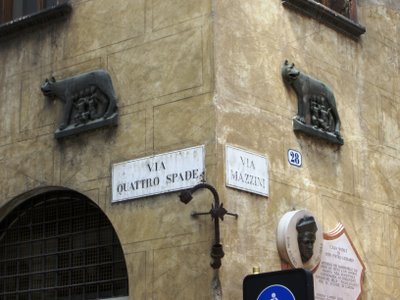
Then, some cities use unique street nomenclature, as in Genoa's caruggi and vicoli, terms which come from the Ligurian dialect.
Venice, however, takes the cake when it comes to this subject.
Here, a campo is a public square; a small one is called a campiello.
A Venetian bridge is street is called ponte. A street is a calle; a particularly narrow one a calleta. However, I also saw narrow streets named rame, riva and fondamenta. The three days I spent in Venice didn't allow me enough time to observe the distinctions between them. However, here's a good primer on the mysteries of Venetian addresses.)
Still, the place names are a good indicator of the sort of activity that took place in a particular area. Near the Rialto, for example, place names around the vegetable market indicated where fish, bread and other foods were sold. Some of those words were in Spanish or Arabic, so one could also surmise the origins of the merchants who did business in those locales. (La Serenissima has always been cosmopolitan.)
Here's where a greengrocer (l'erberia, from erbe, vegetables) set up shop, in a covered walkway through a building (sotoportego):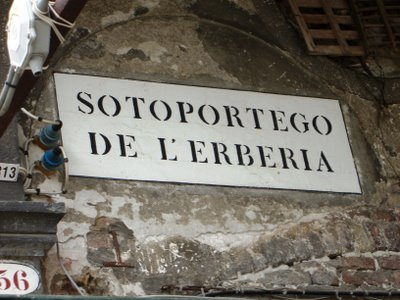
Our Venice guide Laura gave us a very good idea of what we would have seen on those streets five hundred years ago; from Jewish moneylending tables to bakeries (panataria) and orange sellers (naranzaria), to more venal pursuits. Campiello de la Stua was one example.
Laura told us stua means "stove" in the Venetian dialect. Apprently, way back when, this little square was the site of big stoves which heated water for bathhouses. As with many bathhouses today, it was also the red light district. So you can walk through the adjoining sotoportego (a covered walkway going through a building) to the neighboring street.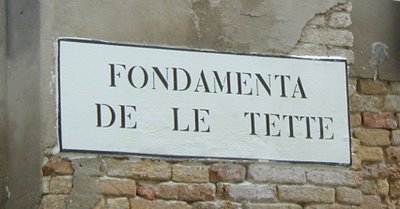
Translation: "Street of Breasts." Only the word is the colloquial term for mammary glands. You get the gist. The prostitutes who lived around this fondamenta and its adjacent bridge, Ponte de le tette, advertised their wares by baring their breasts at their windows. And there were many. Laura told us there were approximately eleven thousand prostitutes in Venice in the 1500s - to a population of about two hundred thousand.
The ladies are gone now, but their memory lives on. This painting was in an art gallery on Fondamenta de le tette.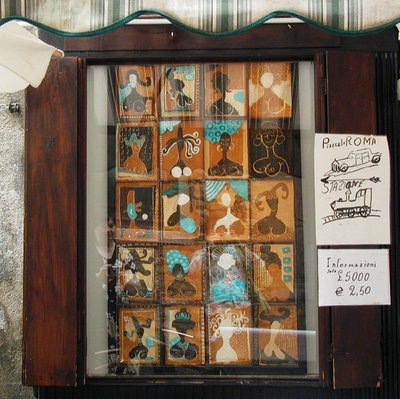
Gillian Coldsnow
Posted by
Gillian Coldsnow
at
9:49 AM
0
comments
![]()
Labels: bridges, calle, campiello, campo, fondamenta, italy, naming, riva, signs, sotoportego, streets, venice
This statue of opera composer extraordinaire Giacomo Puccini is at his birthplace in Lucca, Tuscany.
I didn't go to Tuscany on this trip. Puccini found his way to me. Honest!
How? Through NWPR listener Ken Pitman of Prosser, who met me in Copenhagen and didn't know it.
Turns out Ken and I were on the same delayed SAS flight from Copenhagen to Seattle. When he read my blog post about the long trip back to Seattle, something clicked. Ken writes:
"It was the reference to lightning that gave it away. There you were with your NWPR shirt, and I almost struck up a conversation, but then I thought to myself, naw....just somebody who supports NWPR. I was wrong, and apologize in retrospect for not taking advantage of in person someone who I listen to every morning as I commute between Prosser, and Yakima. "
Knowing how I love The Man, Ken sent me this picture he took while in Lucca - possibly at the same time I was basking in the composer's aura at La Scala in Milan! This statue stands in the courtyard of the house where Puccini was born on December 22nd, 1858.
(I once had a boyfriend whose birthday is December 22nd. It went badly. Guess it's just as well I only know Puccini through his music and statues.)
Grazie mille, Ken!
Posted by
Gillian Coldsnow
at
12:16 PM
1 comments
![]()
Today's main article in Slate Magazine by Jacob Weisberg uses the title "Deathstyles of the Rich and Famous," which is the title of my post on May 20th. I used the title first!!
His article is about skiing, boating and flying accidents. Mine is about a grand cemetery in Milan.
Posted by
Gillian Coldsnow
at
12:11 PM
0
comments
![]()
In Venice, our opera experience was a small and fairly intimate event held in a 15th century church. 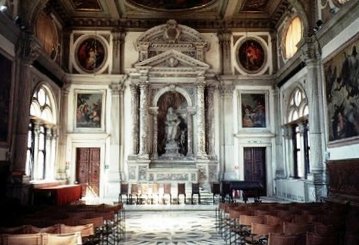
This church is part of a school founded in 1261, Scuola Grande di San Giovanni Evangelista. It was renovated in the 1600s, and has been an art museum since (I believe.) It's chock full of incredible works of art, even by Venetian standards: statues, tapestries and paintings created by the likes of Tintoretto, Veronese, Tiepolo and other giants. (More images of the Scuola's treasures here.)
This was the ceiling.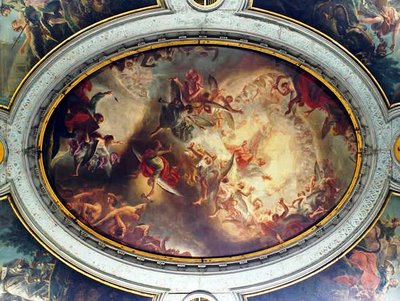
The performance was by Musica in Maschera, a fine 8-piece chamber ensemble with a soprano and tenor, and a ballet dancer, performing in authentic 17th century Venetian costumes and masks. All were fine performers, but honestly, the dancer had so little room to maneuver at the front of the church that she ended up looking ridiculous. The musicians were great, helped out by the fabulous acoustics of the building.
So it was a concert performance. Where's the drama?
OFF STAGE.
The singers, for the most part, took turns to sing at the front of the church. When he was not "on," the tenor, a thirty-something in fine voice, was carrying on with his much-younger girlfriend seated in the audience. My friends told me they were actually making out between arias!! And this was a church, mind you.
Now the drama begins.
After the enjoyable evening, our group walked through the little alleys towards the Rialto. Suddenly, we we heard an approaching commotion and saw the tenor, now out of costume, running towards us as fast as his legs would carry him, casting glances backwards as he pushed past us.
A few seconds later we saw what he was running from - his girlfriend, with a look on her face that would turn Medusa's blood cold. Just as she passed us her beau went over a bridge and out of sight. With a heartfelt snort and a look of absolute fury, she abandoned the chase, threw up her hands in disgust and stomped her way toward the canal.
I'd pay good money to find out what happened when she caught up with the tenor.
Is he singing castrato now?
This is the audio spot I sent from Venice on this incident.
Gillian Coldsnow
Posted by
Gillian Coldsnow
at
8:09 PM
0
comments
![]()
Labels: drama, opera ballett, Scuola Grande di San Giovanni Evangelista, venice
Remember this picture of my Ligurian seafood platter that made so many readers gasp, salivate and then curse me?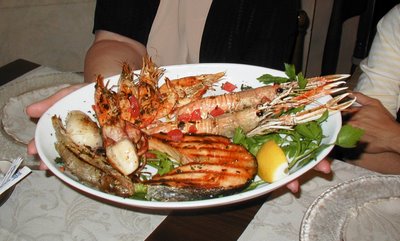
I was just reading over the earlier posts and saw that I'd promised more information on the wonderful restaurant, Lupo Antica Trattoria.
Even though it was barely 25 meters from my hotel, I would have missed it save the recommendation of Signora Arianna. As I've told you, Genoa is a maze of narrow little alleys called caruggi, some of which disappear steeply downward from main streets to goodness knows where.
Now I know some of them disappear into heaven.
Such was Vico Monachette, a stone's throw from the Ramada on Via Balbi, in the heart of medieval Genoa. Lupo's is a warm and cozy little inn, which opened a little early for us, thanks to the sainted Arianna's advance calls. The restaurant prides itself on serving the best Liguria has to offer, prepared creatively. The chef adjusts the menu weekly to accomodate the freshest catch or produce. The bilingual menu's English section was charmingly awkward, a word-for-word translation from Italian.
Liz, Cherri, Arianna and I began our meal with an antipasto of grilled radicchio in a roquefort-pine nut sauce. The bitterness of the vegetable was perfect with the creamy cheese and nuts. There was still a little crispness to the radicchio, which contrasted nicely with the velvety smoothness of the sauce. Our primo piatto was a fresh herb-filled pasta called pansotti, which could be described as triangular ravioli. These little "potbellies" (for that is what the word means, I'm told) came dressed in a creamy walnut sauce (salsa di noci) that screamed, surrender to me!
Our primo piatto was a fresh herb-filled pasta called pansotti, which could be described as triangular ravioli. These little "potbellies" (for that is what the word means, I'm told) came dressed in a creamy walnut sauce (salsa di noci) that screamed, surrender to me!
You've seen the picture of our grilled seafood entree - scampi, prawns, salmon, octopus, and little white fish. It was just barely seasoned. I really appreciated the restraint. The chef was obviously skilled and could have done a million things to the dish, yet chose to respect the quality and freshness of the ingredients and let the food speak for itself. You know, this takes a generosity of spirit - to take oneself out of the equation and let the seafood be its own star. Bravissima.
Our other entree was a typical Ligurian dish - fish and potatoes in basil pesto. So simple, so delicate, so fresh, and oh, so delectable.
The house red wine was an excellent dolcetto, the charms of which I've already sung loud and long in several previous posts. It's most definitely my favorite red now.
We finished up with the best tiramisu I've ever tasted. If you've ever tasted the "faboo" tiramisu made by my dear friend Tina, you'll know this praise is not easily earned. Lupo's version was whipped up to an ethereal airiness, yet the tremendous chocolate, coffee and grappa flavors stood confidently through those creamy layers. But just as I was about to swoon from this, Arianna gave me a taste of her tarte tatin, as warm upside-down apple tart. (Yes, it's a French dessert. Let's not quibble about that while I'm having a moment here.) O Puccini! O Rossini! O Verdi!!! See why I love Genoa so?
As we were leaving I spied The Quartet and wandered over. They were in the middle of rolling their eyes over risotto dell'arancie, Orange Risotto. I wished it was time for dinner to start all over again.
Lupo. Just one more reason I have to get back to Liguria.
Gillian Coldsnow
Posted by
Gillian Coldsnow
at
6:13 PM
1 comments
![]()
Labels: genoa, la scala restaurant, ligurian food, lupo, trattoria
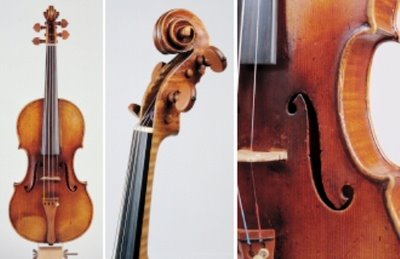
Genoa’s best-known musical export could well be the violinist Niccolo Paganini, still acclaimed by some as the greatest violin virtuoso of all time. Born in the port city in 1782, he was a performer of such brilliance and drama that women would faint at concerts. Even some men would weep. How to explain such incredible virtuosity? Oh, of course it had to be......could it be......SATAN? (reverberate! reverberate!)
Gosh, if I was Genovese I would really insulted. What do you mean, you don’t think one of our boys could be this good unless he consorted with the devil?
In any case, Paganini’s favorite instrument was a Guarneri, nicknamed Il Cannone (“The Cannon”) because of its soaring resonance – some even say it’s an aggressive sound. The violin is considered Guarneri’s finest creation; the last of the great violins made in Cremona. At Paganini’s death, he gave Il Cannone was given to his beloved city of Genoa.
And that’s where we saw it, in a glass case in a dimly-lit room in the Palazzo Tursi Museum. I don’t know all that much about violins, but I could tell there was something different about this particular instrument. I later read that the neck is short and flat – and obsolete. There are dark spots in places – greasy fingers? did Niccolo forget to wash his fingers after indulging in Genovese farinata? Just imagining Paganini’s very hands on that violin before me generated a frisson.
Also in that room is the only copy every made of Il Cannone. The virtuoso gave that to his favorite student. It’s possible that’s the only reason we remember the student’s name, as this instrument is known as the “Sivori.” Tsk. He played second fiddle to...his violin?
(Sorry, it was too good to resist.)
Il Cannone is not confined to life in a vacuum. Every year the winner of Genoa’s "Paganini Competition" (open to anyone under age 34) earns the right to play the hallowed instrument on October 12, Columbus Day. Great way to tie it in to Genoa's other favorite son, Christopher Columbus. But the person who created the most controversy with Il Cannone is an African-American musician, Regina Carter. In 2001 the City of Genoa invited her to play jazz on Paganini’s Guarneri. (There's that whole devil thing again!) It was scandalous, but ultimately, Miss Carter charmed all the skeptics, and everybody lived happily ever after.
Incidentally, pictures are not allowed at the museum. The images above are from the City of Genoa website.
And here's an in-depth article (bilingual) on the technical aspects of Il Cannone.
I leave you with a Paganini quote:
"I am not handsome, but when women hear me play, they come crawling to my feet."
Gillian Coldsnow
Posted by
Gillian Coldsnow
at
5:29 PM
0
comments
![]()
Labels: genoa, il cannone, paganini, violin
Venetian doges/dogs had their turn in an earlier blog post, but the cats of La Serenissima should get their due. After all, there are lions lying all over the place! The lion is the symbol of the Republic's patron saint, Mark the Evangelist. But you can see some live Venetian felines at this site.
One kitty that caught our attention lived in a bar near our hotel. Ljiljana was especially taken with Martino, and even took Melinda there the following day to meet that fine cat.
Posted by
Gillian Coldsnow
at
7:43 AM
0
comments
![]()
Okay. So who goes to Italy to eat liver and onions?
I know, I know, my odd tastes are nothing new. But for years I’d read (again, damn you, La Cucina Italiana, for getting me so obsessed) about the utter delicacy with which Venetians prepare calves’ liver. So one evening, I dined at a little trattoria in Venice with Sanni, Barbara, Beverly and John, with Blaine and Sandy at the next table. I ordered fegato alla Veneziana.
I made sure my dinner companions all got a taste. The verdict: very positive.
The liver was tender and mild, thanks to an overnight soak in milk. It was sliced thinly, the cipolle (onions) sautéed to just the right degree of caramelization, and the pan deglazed with a good white Veneto wine. Mine came with a side of Arborio rice, a perfect foil for the rich pan juices.
My dinner was made so much better by the fabulous company. We laughed and roared, and giggled when the suave, charming, devilish waiter Lucio decided to anoint us with new names: Barbara rose to canonization immediately as “Santa Barbara,” Sanni was “Sonia,” and John was “Don Giovanni!” I was dubbed Giulietta. (Beverly – I can’t, for the life of me, remember what he called you!)
As the plates were cleared away, I introduced the group to the joys of caffe corretto, or ”corrected coffee,” set right with a little splash of spirit. That night we chose Sambuca. And why waste an evening with a devilish waiter without introducing flames? So in broken Italian I asked for “sambuca la fiamma.” Float a few espresso beans in a shot of the sweet anise liqueur, then flame it. I had my saucer in hand, ready to snuff the flame, but we were having such an animated conversation about sambuca that I failed to actually put out the flame. Our glass broke – in a perfect straight line around the circumference of the glass. Italian crystal, man!! It even breaks with style.
Oh, sambuca la fiamma? A big hit with the group. Almost as much as Lucio.
Venice can be hard to take, especially if you go to THE tourist areas.
Piazza San Marco is a surging throng of tourists pushing their way to the Palazzo Ducale, or the Basilica, which dates to the 9th century.
I found it absolutely impossible to take in the Basilica treasures. I'd been waiting decades to see the mosaics and sculptures, but a few minutes is all one can get. You are part of a continuously moving line which begins at one door, snakes its way through the immense structure then ushers you out through another portal. The whole experience lasts just a few minutes. Even though Mass was in progress in one of the chapels, the constant hum of a thousand whispers never subsided. In fact, it was even punctuated by ringing cell phones. I was really annoyed by the lack of respect.
However, there still is a lot to enjoy in Venice, far from the madding crowd. Having grown up on a small island, I adored the ubiquitous proximity of water. As you probably know, there are no streets in Venice (well, there are streets in parts of Venice, such as Lido, out of the main tourist thoroughfare.) Instead one gets around on foot and by boat.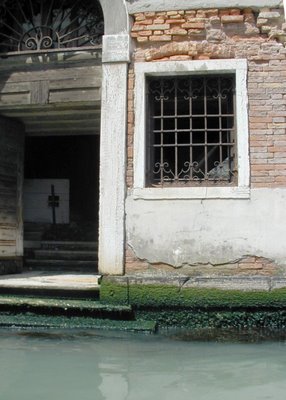
Above: pull your boat right up to your doorstep!
One evening, I saw a couple of men standing by water's edge with a leather sofa and love seat. They were obviously waiting for transportation to take their newly-acquired furniture to their home. Venetians probably wouldn't do well with massive Costco shopping trips.
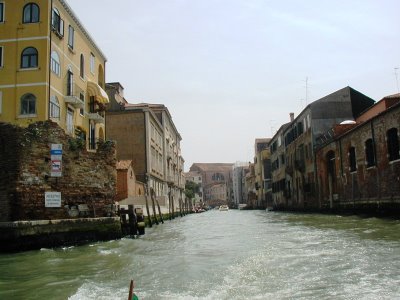
Above: one of the larger canals in a busy area.
The next two shots, though, show a very different canal scene - one I loved. A narrow little canal in a residential area, at dusk. All the boat motors were silent, and the only sounds I heard were of peoples voices - talking, laughing, some singing in the distance. 
(Love that laundry line hanging out ACROSS the canal!)
This is another little canal, in daylight. I took this picture while riding the back of a private "taxi" to a great glass factory on Murano Island.
Here's the audio spot I sent from Venice about the difference between San Marco and the quiet areas.
I was last in San Marco at the height of tourist season, in July 1971. I don't remember it being choked with people. Arianna told me that these days, the Piazza is just as busy in January as it in July. And Niccola (a local) told me that Venice can accomodate 20 thousand people a day, according to environmental studies....yet there are at least 40 thousand visitors daily! No wonder it's sinking.
Posted by
Gillian Coldsnow
at
9:52 AM
0
comments
![]()
The image below is from Verona's Piazza Bra webcam, at about 6PM local time on Tuesday 6/6/06. (Yes, I know wayyyyy too much has been made of this date. I'm not paying too much attention to it.)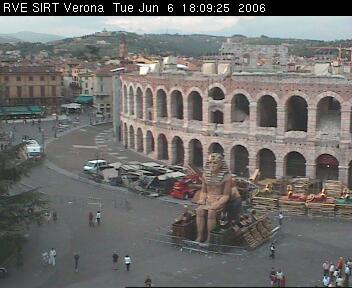
When we were in Verona on May 25th, the set was in front of the Town Hall. As you can see, it's now right outside the Arena, where Verdi's beloved opera has been performed every summer for a good many years.
This year "Aida" premieres on June 25th.
Posted by
Gillian Coldsnow
at
11:35 AM
0
comments
![]()
Earlier, I wrote about arriving at the pier in Venice. After that we boarded a little water taxi to our hotel, the Amadeus.
From L-R: Blaine, John, Sanni, Arianna, Sandy, guide Christina (back to camera), Venetian boatman, and Melinda.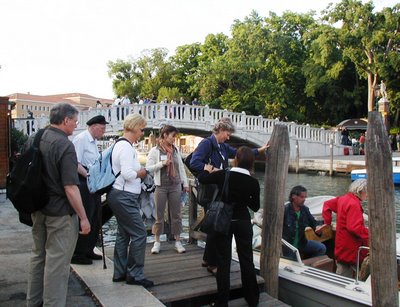
Our luggage went on a different boat. As I was boarding the water taxi, a little skiff loaded with our luggage zoomed off. I was rather alarmed to see the skiff was named the "Trashbagger!"
There were no mishaps with our suitcases. Maybe because of the strong presence of law enforcement.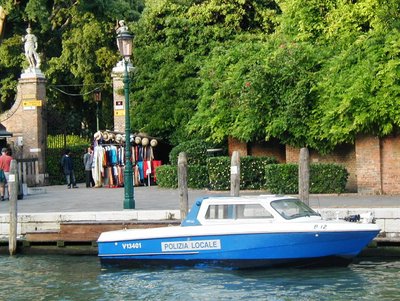
Posted by
Gillian Coldsnow
at
10:31 PM
0
comments
![]()
Labels: arriving, piazzale roma, trashbagger, venice
Being a Republic, Venice never had a king. Instead, it was ruled by the doge - a word which comes from the same root as duce and duke.
Our Venice guide Laura pointed out pictures of the various doges in the Palazzo Ducale. They'll all gray-haired men! It was the practice to pick an old man as doge, to make sure that his reign would naturally be short. Here's more on doges, in the audio spot I sent from Venice.
Here, then are some pictures of the Doges of Venice.




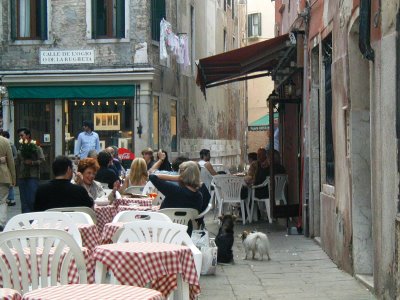

Posted by
Gillian Coldsnow
at
10:07 PM
1 comments
![]()
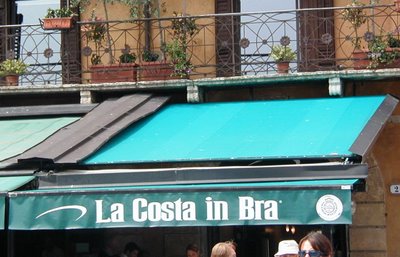
Verona's Piazza Bra (here's their webcam) is a big, full, beautiful... SQUARE, flanked by a Roman arena, fountains, statues, and a great restaurant and shopping area. Our guide Alberto told us "Bra" is derived from a word in the Veronese dialect that means "big wide open space."
This Roman gate flanks Piazza Bra. I believe those little brick projections on the top are called "crenels," and were for the archers to do their job with some protection. Clever design! (You'll see crenellated Roman walls all over Verona.)
This picture really doesn't do justice to the beautiful gate. The blocks of marble range from snowy white to a rose pink. Actually, glance around this beautiful city, and you'll notice a lot of that pink, thanks to the local marble known as "Rossa Verona." You'll see blocks of it used in the construction of the arena, which dates to the first century B.C.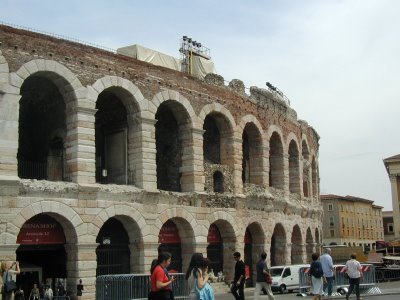
Verona's arena is older and in better condition than Rome's Colosseum. The interior is in good shape, while a part of the outer wall still rises above the amphitheater. These are the four remaining arches of that outer wall.
We we curious enough that we paid the entry fee to experience the interior of this imposing structure.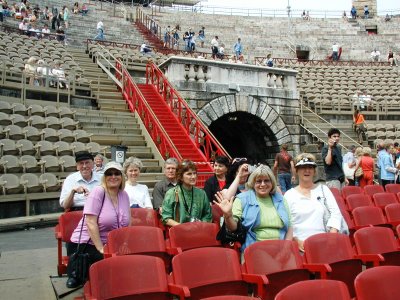
Imagine watching a show on the stage of an ancient Roman amphitheater! That's what happens every summer in Verona. Thankfully, it's no longer spectacles of gladiators and wild animals and rivers of blood. Instead, there are rock concerts, and operas. When we were there, we saw the massive set of Zeffirelli's "Aida" production right in front of the town hall, Palazzo Barbieri (below). It's right by the Arena, waiting to be moved to the stage.  Note: on Monday morning, Pacific time, I saw the Piazza Bra webcam showing the pharoah figure right outside the arena walls! The next staging of Aida is drawing close. Oh that we could be there for it! Maybe another opera trip?
Note: on Monday morning, Pacific time, I saw the Piazza Bra webcam showing the pharoah figure right outside the arena walls! The next staging of Aida is drawing close. Oh that we could be there for it! Maybe another opera trip?
Here's a link to the Arena's official website. It has some great pictures of the productions on the arena stage, and is really worth a look.
Posted by
Gillian Coldsnow
at
10:26 AM
0
comments
![]()
Labels: area, arena, crenel, gate, la costa in bra, piazza bra, pink marble, verona
Even though I ate incredibly well in Italy, I actually lost a few pounds during the trip. I'm sure it's not just in Italy that portions do not approach the serving sizes to which we are accustomed in the U.S.
What other reasons? For one, meals are not taken on the run. For example, I don't recall seeing a single person sipping coffee in to-go paper cups; it was rare to see people eating anywhere other than seated at a table. Sometimes I'd see people eating while standing at a bar (it actually costs less to have you coffee or snack while standing.)
And the freshness. Man oh man. The fruit and vegetables were extremely fresh everywhere we ate. Nothing seemed processed for long-term storage.
Here's an article from the New York Times on eating the Italian way that delves into this subject.
Posted by
Gillian Coldsnow
at
10:19 AM
0
comments
![]()
Originally posted 5/20
Il Cimitèro Monumentale ("Monumental Cemetery)
We only drove by Milan's Monumental Cemetery but didn't have time to stop, so you'll have to go the the link above to see details. "Grand" doesn't even begin to describe the entombment of Milan's most prominent citizens. They have to pay for the privilege of being buried here, and must be sure to book a spot years in advance of their Estimated Time of Departure.
One interesting bit that came up with this item: Arianna says that in Italy, burial in public cemeteries is free. She was a little shocked that dying in the US costs money!
As we drove into Milan, we also passed a very colorful and eye-catching tower. Arianna told us many people are curious about the structure, but it has no significance other than its visual impact.
Posted by
Gillian Coldsnow
at
9:06 PM
0
comments
![]()
Originally posted 5/22
Along the way we passed one picturesque little town after another. They all seemed to have laundry hanging out the dry and small but healthy rooftop gardens.
Along the way, we crossed the river Po and agricultural country. Lots of rice, wheat, some corn – and for some reason unknown to me, lots of stunningly vivid red poppies growing in patches amidst the crops. 
We also saw tiny little strips of grape vines scattered here and there – most likely raising just a small supply of grapes for the farmer’s personal winemaking.
As Genoa came within view, Arianna pointed out a old church on the hill above the sea. She said sailors used to go there to pray for safety on their long and often dangerous voyages. Their wives would also go there to pray for the men's safety. Our bus driver piped up that one could be sure some wives prayed fervently for their husbands NOT to return! No doubt.
Posted by
Gillian Coldsnow
at
8:19 PM
0
comments
![]()
Labels: crossing the Po, genoa, milan, road